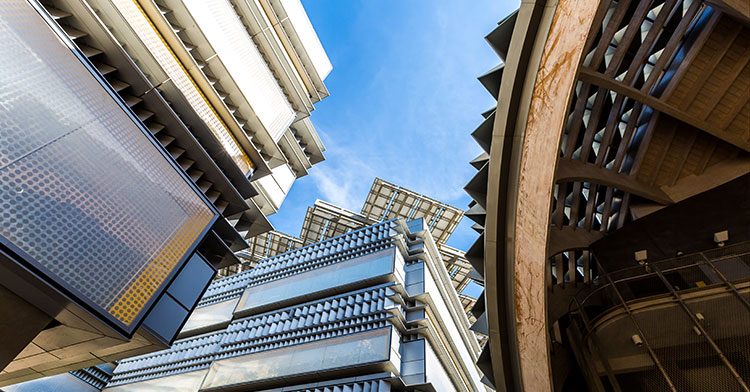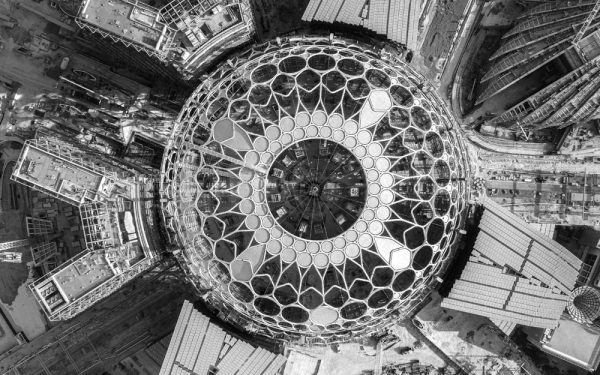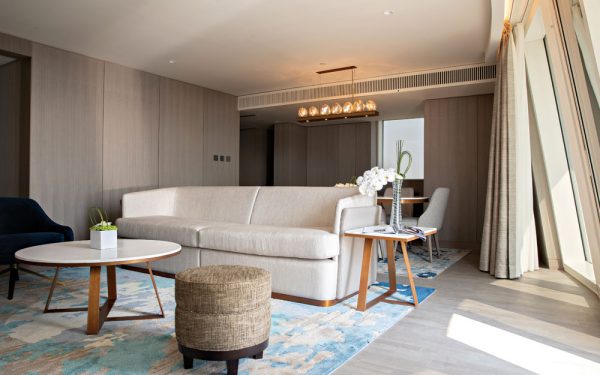This is the stuff of sci-fi. Terracotta walls punched with tiny square windows curve sinuously around paths, and a hedgehog-shaped building curls up against the heat. There are giant wind towers, open plazas that funnel into miniscule walkways, and seemingly random gusts of wind that can blow an unprepared visitor off course.
Amidst this surreal landscape, Chris Wan crouches on the floor, beaming. “You feel this?” he gestures, patting the stone animatedly. “It’s 40 degrees outside. But this is not burning.”
This is Masdar City, an urban dreamscape in Abu Dhabi brought (partly) to life over the last 12 years by Masdar, a subsidiary of state-owned Mubadala Development Company. Created in order to both diversify beyond oil and become a leader in renewable and clean tech, Wan is the head of city design management for the sustainable real estate section of the firm. He is demonstrating how the effects of radiant heat can be counteracted not using any complex technology, but a few simple measures that have existed in the UAE since it was a cluster of tribal communities: the use of shade, of wind, and of sunlight.
Since 2006, the renewable energy company has separated into three business units including Masdar Clean Energy, Masdar City, and Masdar Capital, and topped off by Khalifa University of Science and Technology, whose current active projects include developing solar cells that can be used on spacecraft, and a new kind of evaporator for water desalination.
In the city itself is a range of corporates – Siemens Middle East is based there, as is General Electric and Mitsubishi – and it also acts as the headquarters of the International Renewable Energy Agency (IRENA), a 158-member community whose mission is to “support countries in their transition to a sustainable energy future.” Buildings are backed up by local and international accreditations. Siemens Middle East is certified with LEED, the most widely used green building rating system in the world: in its first year of operation, the office celebrated saving 63 per cent and 52 per cent of energy and water consumption respectively, compared to a standard Abu Dhabi office building.
The project still has a way to go – of a proposed 3.7 million feet, only 200,000 is built on and occupied – but it is just one example of the proliferation of eco-architecture that has taken place in the region over the last decade.
To consider the UAE’s attitude to architecture, one first must go back in time. Elie Mrad is the head of architecture for Arcadia Middle East, which is currently work on developing the first phase of the mammoth Aljada project in Sharjah.
Estimated to spread over 24 million square feet, the team employed Zaha Hadid Architects to design the central hub, a typical Hadidian modernist creation of water droplet-shaped buildings. The most interesting aspect of the project is its adherence to sikka, the pathways used by communities in the Middle East to create shaded passage, and to help funnel windflow.
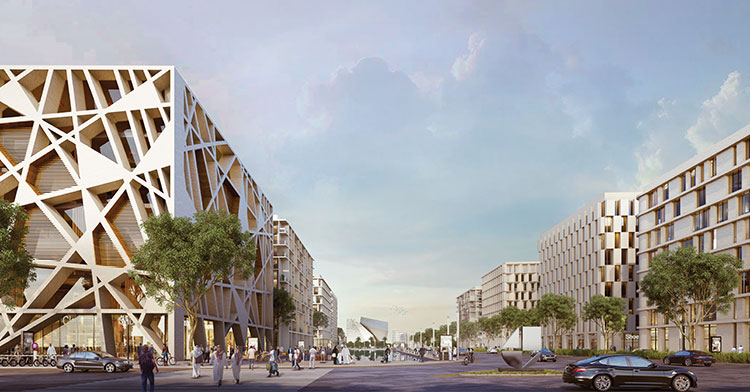
“Al Khan is the oldest part of Sharjah and these are the oldest villas,” says Mrad, pulling out an aerial recreation of the ancient villages that used to pepper the emirate’s coasts. “They aren’t there any more, but what we’ve done is replicate this typeology, and to use it in a contemporary way in our own development.”
Similarly at Masdar, ancient Arabic techniques are used to significant effect. “LEED and Estidama are very important but not the be-all and end-all,” says Wan, referencing the international and local accreditations for green buildings.
Working with Foster and Partners, the original master planners to study how the previous residents of Abu Dhabi lived – with no air conditioning, no automatic blinds – helped them develop the passive design that became the crux of the city.
“We don’t want huge massive windows that let in loads of heat. We don’t want a window, or a doorway, to face the sun. Buildings must be close together to create shade, and you must understand where the wind is coming from. This is passive design,” he says. Wan describes how the courtyard – so important in the culturally private background of the emirates – also acts as a cooling system. The optimum angle for the sun hitting the top edge of a building? 35 degrees. Too high a building and too small a courtyard mean the heat is trapped – too low a building and too wide of a courtyard, there is no shade.
“If you look at us on Google maps, we don’t follow the same grid as our neighbours. It seems to be, in fact, very arbitrary,” says Wan. “But we are oriented like this to capture the wind coming from the northwest, and going to the southeast.”
The waves of migration into the country, from Egyptian to Lebanese, Russians to Azerbaijanis, created an architectural diversity where every type of project was considered, every kind of national style imprinted. Aesthetically it was somewhat of a mishmash; ecologically, unconsidered. A changed yet cohesive mindset will be an important part of developing a coherent eco-minded typology in the country, agree architects.
Baharash Bagherian is the founder of Baharash Architecture. Involved in the second phase of Sustainable City, as well as plans for eco-resorts across the UAE, he states that the typical thrill-seeking adventures visitors to the country indulge in, can impact people’s perception of the country.
“People think eco-tourism can only exist in places like Costa Rica, but there is so much variance in the topography of the UAE, from its wadis to oceans, mountains to desert. The question then becomes, how do you create opportunities beyond off-roading in 4x4s?”
Bagherian describes the efforts of several projects – still in planning phases – to become conservation zones rather than just hotels. “Education is the biggest part of eco-tourism, and it goes beyond reusing towels in the bathroom. How is the food produced? Can it be made by local farmers? Is furniture locally made, are paintings by local artists? Are there activities that represent the culture of the region, such as falconry displays?”
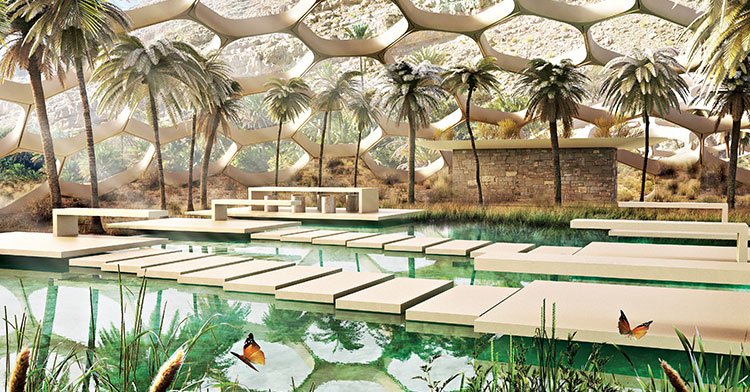
Sustainable City is one effort within Dubai to create a truly eco-minded, utopian suburb. Walking around the community, the feeling is of a Middle Eastern eco-utopia.
Its biodomes are filled with herbs that residents can take away (with a voucher system: even loyalty is assumed in the City), donkeys graze quietly in the shade, and healthy-looking residents jog past with pushchairs and Apple watches.
Atop each of the houses’ roofs is a solar panel, and inside UV reflective paint and insulation cut down on air conditioning costs. In the outer circles there are running tracks, a ring road for vehicles, even an equestrian centre. The development company, Diamond Developer, has a plan that extends beyond mere comfortable living. The team has been engaging with academic partners such as Herr-iot-Watt and the American Universities of Beirut and Cairo, as well as green councils and initiatives, with the collective goal of reducing the country’s carbon footprint – in 2010, ranked the highest in the world.
There are two major challenges towards the advance of eco-architecture within the UAE, architects tend to agree: the client-side knowledge gap and the physical conditions.
Extreme temperatures and an arid landscape make eco-efficient measures tricky. There are no dense jungle canopies to provide shading, blustery sand reduces the effectiveness of solar panels, and any water feature comes at a cost: forget what designers may creatively describe as water features with reuse. Says Wan: “How can water be reused in the summer? The spray just evaporates.”
For state-of-the-art living within an extreme environment, air conditioning is undebatable says Sven Mueller, founder of Dubai-based architectural firm SvenM. “There is no other way to achieve that. It comes back to, how do we protect buildings from these extreme conditions to save energy, and how can we produce additional energy to counteract that?”
There can also be a presumption that an oil-rich UAE should not need to concern itself with building sustainably, adds Yousef Baselaib, Executive Director of Masdar’s Sustainable Real Estate division.
“When we started designing the project in 2006, that was a big challenge, as this concept of sustainable architecture was not yet addressed in the region,” he says. “We are rich in hydrocarbons now, but we are not looking for today – we are looking into the future.”
“Most importantly, the client has to feel the wish to be more eco-friendly,” adds Mueller. “Someone who has a project that they are looking into building should have this core aspiration first of all: to be aware that they are going to create a carbon footprint here, but that there are measures to reduce the harm. They should be curious about how they can achieve that.”
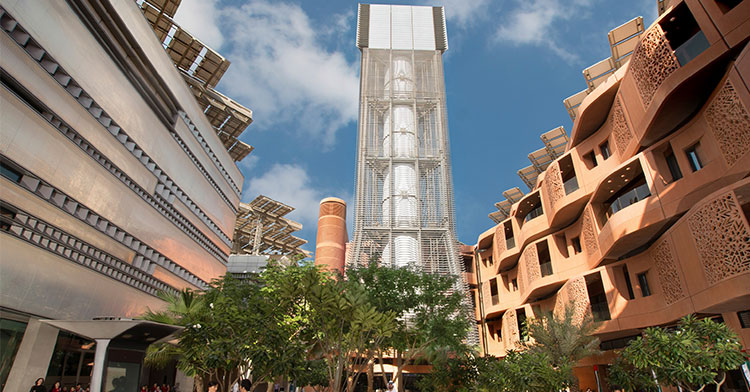
This can be possible. Mueller speaks positively about a project undertaken for Al Ghurair University. Seeing the chance to transform the space using micro-measures, SvenM sought to occupy as little space and noise as possible in a building continually used by students.
“Our designs are all a mix of measurements or interventions,” says Mueller. “There are a few elements that we add, a few that we remove and a lot that is modified. There is a large curtain wall glass façade at the lobby entrance which gives a beautiful natural light into the whole building that we want to sustain. We just added large louver structures [angled shutters] in front, to protect the curtain wall from the sun’s direct impact, but to maintain all the light.”
Passive design had its birth in Mies van der Rohe’s Villa Tugendhat in Brno in 1930. It goes beyond modern labels of “eco” and “green”, or any formal accreditations. It is both ancient and modern, but its application is vital for the continued eco efforts of the UAE. It will be the architects of the region who will drive this change. As Peter Davey of The Architectural Review has said: “The environment must remain with those who continue to weave everything together: an essential way of thinking if we are to survive as a species.”
Back at Masdar City, one worker pauses at the plaza, where the venturi effect funnels the wind briskly through the space. “I don’t even park my car here in the winter,” she says conspiratorially, glancing from side to side. “It’s way too cold.”

